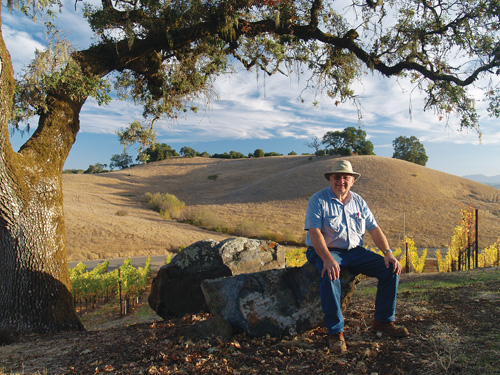The Pinot Noir winegrape is considered “sensitive” and hard to cultivate, but more than a few local wineries seem to have it in the bag, gaining worldwide recognition for wines that ultimately end up being enjoyed at the table with family and friends.
As a thin-skinned red variety, Pinot Noir has achieved esteemed winemaking success in only a handful of growing regions, and the Russian River Valley is among them.
Influences
The Pinot Noir grape has been described as difficult, finicky, mysterious and more by those who’ve grown it; but Joe Rochioli, Jr., 79, of Rochioli Vineyards and Winery in Healdsburg has a different take: “It’s just like any other crop–the years and the weather will affect it,” he said.
Every harvest is different, and Rochioli has seen a number of them, witnessing first-hand the way that not only weather but also soil, pruning techniques and thinning can influence the quality of the Pinot Noir crop. “I’ve been doing this all my life,” he said. In fact, Rochioli was one of the first to plant Pinot Noir in the Russian River Valley in the 1960s.
The unique weather conditions of the Russian River Valley growing region tend to satisfy one of Pinot Noir’s basic primary needs: cooler temperatures than many of the other winegrape varietals. “The weather here is ideal for Pinot Noir. The fog belt coming up through the river cools the nights, and the days are warm,” said Rochioli, who makes
daily drives down vineyard rows to check on grapes.
Daytime temperatures that don’t creep above 95 degrees and nights that drastically cool are necessary for this winegrape to thrive. The fog that rolls in during the evening hours generally drops the temperature by 35 to 40 degrees Fahrenheit during the night, promoting a long, slow growing season. Wind, frost, soil conditions, yeast in the winemaking process and pruning methods can negatively affect Pinot Noir, more so than the other varietals.
With lower yields, Pinot Noir can be a pricey grape to grow; but for those who favor the wine, it’s worth the trouble.
Perhaps it’s the grape’s heightened sensitivity that also makes Pinot Noir exceptionally reflective of its terroir or growing environment, such as mineral elements in the soil,
climate and geography, enabling different vineyard locations to produce significant variances in the grape and, thus, the wine. This concept explains the broad range of flavors, textures, impressions and bouquets that make Pinot Noir intriguing.
“Our Pinot Noir wines have a very unique nose (scent or smell),” said Rochioli. Traditionally, Pinot Noir is described as having flavors and aromas reminiscent of raspberry, red or black cherries, as well as some earthy notes of mushroom or “farmyard.” But there is plenty of play within the varietal and descriptors like pepper, spice, cinnamon, tea, tobacco, anise, blackberry and wild strawberry also show up in Russian River Valley winemakers’ and wine tasters’ notes.
Russian River Valley AVA Reaches 30 Years
The Russian River Valley Winegrowers (RRVW) are throwing a party to celebrate the 30th anniversary of the Russian River Valley appellation and honor the association’s founding members at the 18th annual Grape to Glass on August 17 at Richard’s Grove and Saralee’s Vineyard in Windsor. Tickets are on sale now for the event: Back to Our Roots—A Salute to our Founding Members.
The party starts with a 4 p.m. tasting featuring more than 50 Russian River Valley wineries and growers, small bites from local restaurants and food purveyors and a silent auction, followed by a barbecue and live entertainment. Tickets can be ordered online or by calling 521-2534.
The Russian River Valley was granted American Viticultural Area (AVA) status in 1983. An AVA is granted by the Alcohol and Tobacco Tax and Trade Bureau (TTB), United States Department of Treasury. Each designated winegrape-growing region has boundaries and must be distinguishable by geological features.
Characterized by the Russian River, which acts as a channel that carries fog from the Pacific Ocean aided by the Petaluma wind gap, the AVA tends to be a cooler-climate growing region. Some areas get more fog than others, creating microclimates within the region.
According to the RRVW, the growing season is 15 to 20 percent longer than in neighboring areas, resulting in grapes with higher acidity. About 4,500 acres or 29 percent of the Russian River Valley AVA are planted to Pinot Noir. Chardonnay is the leading varietal, encompassing 6,300 acres or 41 percent of the AVA.
Chefs’ Pairings
Russian River Vineyards in Forestville grows Pinot Noir on the estate property and produces three different Pinot Noir wines. Executive chef Ruben Gomez of Corks Restaurant, located at Russian River Vineyards, has multiple suggestions for pairing Pinot Noir with food.
“One of my favorites is a smoked duck breast with roasted figs and cherries,” said Gomez, who likes how the fruit undertones echo the flavors in the wine. A sauce accompanies the dish, and Pinot Noir wine is one of its ingredients.
Gomez also offers another recipe that is simple and quick. “I like to take a crostini, half a fig, a little blue cheese and black pepper, and bake it just so the cheese melts,” he explained, adding: “With Pinot, this is a marriage made in heaven.
“Russian River Pinots tend to have a strong earthy component along with a fruit profile, so what I choose to pair with a Russian River Pinot would be different than a Carneros (a growing region encompassing parts of Sonoma and Napa counties) Pinot that may have notes of flowers and strawberry,” explained Gomez.
Depending on the wine, Gomez said a Pinot Noir can be light or medium-bodied and may range in color from Garnet to deeper hues of red. Medium-bodied wines tend to have enough character to stand up to dishes that have a gaminess or smokiness to them, bringing out the earthy darker notes in Pinot Noir, he added.
“Then there are the historical pairings, like Pinot Noir and mushrooms,” Gomez said. Certain combinations of food and wine are considered to be companions, he explained, and these are often tried-and-true pairings that have long been people-pleasers.
Because Pinot Noir can work well with smoky foods, echoing tobacco or complimenting earthy notes in the wine, it’s a nice varietal to have on hand for summer barbecues. At the Jaded Toad Restaurant in Windsor, server and wine hobbyist Sarah Petersen suggests trying a glass of Pinot Noir with baby back ribs prepared by chef and owner Leo Tocchini.
These tender, “fall off the bone” ribs have a way of melting in your mouth when combined with a Pinot Noir, and the tangy barbecue sauce brings out some of the bright berry notes in the wine. “They really go well together,” said Petersen.
As for Rochioli, when asked about his favorite dish to have with Pinot Noir, he answered, without hesitation: “I like my Pinot with a nice steak or a pasta with a red sauce.”
Resources
Russian River Valley Winegrape Growers
www.RRVW.org
(707) 521-2534
3210 Woolsey Road
Windsor, CA
Russian River Vineyards
www.russianrivervineyards.com
(707) 887-3344
Corks Restaurant at Russian River Vineyards
5700 Gravenstein Hwy. North
Forestville, CA
Rochioli Vineyards and Winery
www.rochioliwinery.com
(707) 433-2305
6192 Westside Road
Healdsburg, CA
Jaded Toad BBQ & Grill
www.jadedtoadbbq.com
(707) 838-8336
275 Windsor River Road
Windsor, CA









